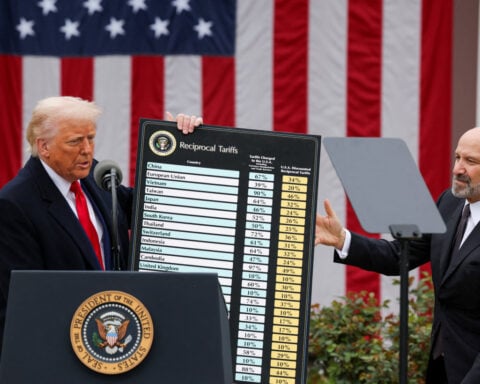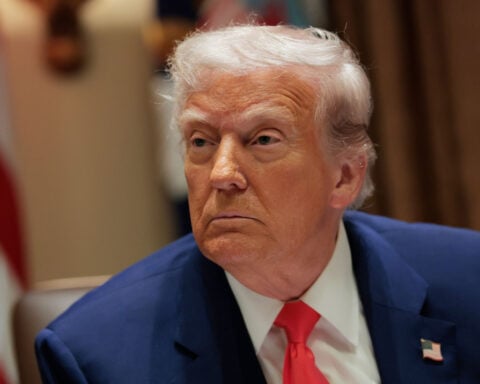By Sarupya Ganguly
BENGALURU (Reuters) - Bond strategists are rethinking long-held forecasts for declining U.S. Treasury yields on the basis that tariff-linked inflation threats could further delay Federal Reserve rate cuts, a Reuters survey found.
Many of those yield upgrades were based on investors demanding higher ‘term premium’ - compensation for holding debt over time - owing to President Donald Trump’s tariff and tax-cut plans, which are complicating the Fed’s efforts to bring inflation down.
Continued U.S. economic outperformance and the Fed's insistence that it is "not in a hurry" to lower rates further have pushed interest rate futures to price in just one more rate reduction this year. Speculators are on the fence about a second.
Vague statements by Trump suggesting "very fraudulent" Treasury debt payment records have rattled bond market participants in recent days, although the remarks have done little to prices and yields so far.
Three-quarters of poll respondents, 16 of 21, in a February 6-11 Reuters survey said the greater risk to their three-month forecast was yields overshooting rather than dropping lower. Yields rise when bond prices fall.
For many, Trump's erratic policy moves — especially on tariffs — add to this risk.
"If we didn't have all these policy changes, I would expect disinflation, a normalization of policy rates and inflation falling back towards 2%. But I have to take into account the changes that could upend that expectation," said Kathy Jones, chief fixed income strategist at the Schwab Center for Financial Research.
"That's why we've shifted our views, basically saying 'okay, the game is on. We have inflationary policies, we're going to get inflation'. We see short rates staying pretty steady, but 10-year yields potentially moving back up to the 5% region."
Jones was in line with a near-60% majority of economists in a separate Reuters survey who agreed tariff-linked U.S. inflation risks have gone up recently and a two-thirds majority of bond analysts from a January survey who said the yield surpassing 5% this year was "very likely" or "likely".
Median forecasts from strategists in the poll were for the benchmark 10-year yield to hold steady at 4.53% in three months and trade at 4.50% in six months, higher than the median 4.40% and 4.35%, respectively, from last month's poll.
Over half revised up their January forecasts, which were themselves broad upward adjustments from December.
"Our outlook is the Fed stays on hold at least until the June meeting - if not longer - and Treasury yields then stay in a range. But there's more risk for yields to move up than down from here especially at the long end because of tariffs and fiscal policy," Jones added.
A majority of forecasters in the survey predicted the yield would equal or surge past current levels at some point in their three-, six- or 12-month forecasts — a radical shift from the landslide majority who almost exclusively saw yields declining in earlier surveys.
"Since the summer of 2022, the consensus has almost always forecast a recession and naturally, for rates to decline, since they have the impression current interest rates levels are way too high. But the U.S. has been growing above-trend since then, and those forecasts have been very wrong," said Lars Mouland, chief rates strategist at Nordea.
"Why should the Fed cut rates? If they cut too much now, they risk firing up an economy already running at a pretty good speed."
(Reporting by Sarupya Ganguly; Analysis by Jaiganesh Mahesh; Polling by Shaloo Shrivastava and Renusri K; Editing by Ross Finley and Christina Fincher)

 Trump has begun another trade war. Here's a timeline of how we got here
Trump has begun another trade war. Here's a timeline of how we got here
 Canada's leader laments lost friendship with US in town that sheltered stranded Americans after 9/11
Canada's leader laments lost friendship with US in town that sheltered stranded Americans after 9/11
 Chinese EV giant BYD's fourth-quarter profit leaps 73%
Chinese EV giant BYD's fourth-quarter profit leaps 73%
 You're an American in another land? Prepare to talk about the why and how of Trump 2.0
You're an American in another land? Prepare to talk about the why and how of Trump 2.0
 Chalk talk: Star power, top teams and No. 5 seeds headline the women's March Madness Sweet 16
Chalk talk: Star power, top teams and No. 5 seeds headline the women's March Madness Sweet 16
 Purdue returns to Sweet 16 with 76-62 win over McNeese in March Madness
Purdue returns to Sweet 16 with 76-62 win over McNeese in March Madness







